I received the
Realme 3
about a week ago, and the two of us went on a short trip too Spain. It wasn’t a romantic one though, as I was covering the Mobile World Congress (MWC) 2019
. I used the Realme 3 as my primary device at the event. And covering the event meant taking a lot of pictures, shooting lots of video, and requiring a good enough battery on your device that does not make you constantly reach for a power bank. These five days were a real test of the new Realme phone, and here’s what my experience was like.
 Realme 3’s Dynamic Black colour variants. Image: tech2/Nandini Yadav
Realme 3’s Dynamic Black colour variants. Image: tech2/Nandini Yadav
The camera needs to do so much better
Since I mentioned that the event required me to take a lot of pictures and videos, I must mention, how I was unable to use the phone for either of that. The Realme 3 sports a 13 MP + 2 MP camera setup at the rear, which features a PDAF fast focusing and f/1.8 aperture. Throughout the event, I had to use another phone for just pictures and videos because the Realme phone failed miserably at it. Despite the dual camera setup, the colours produced in the images by this phone are simply bad. And it gets worse when you are shooting under the booth lighting with a yellow tint — as the images tend to burn out, and look brown. [caption id=“attachment_6189851” align=“alignnone” width=“1280”]
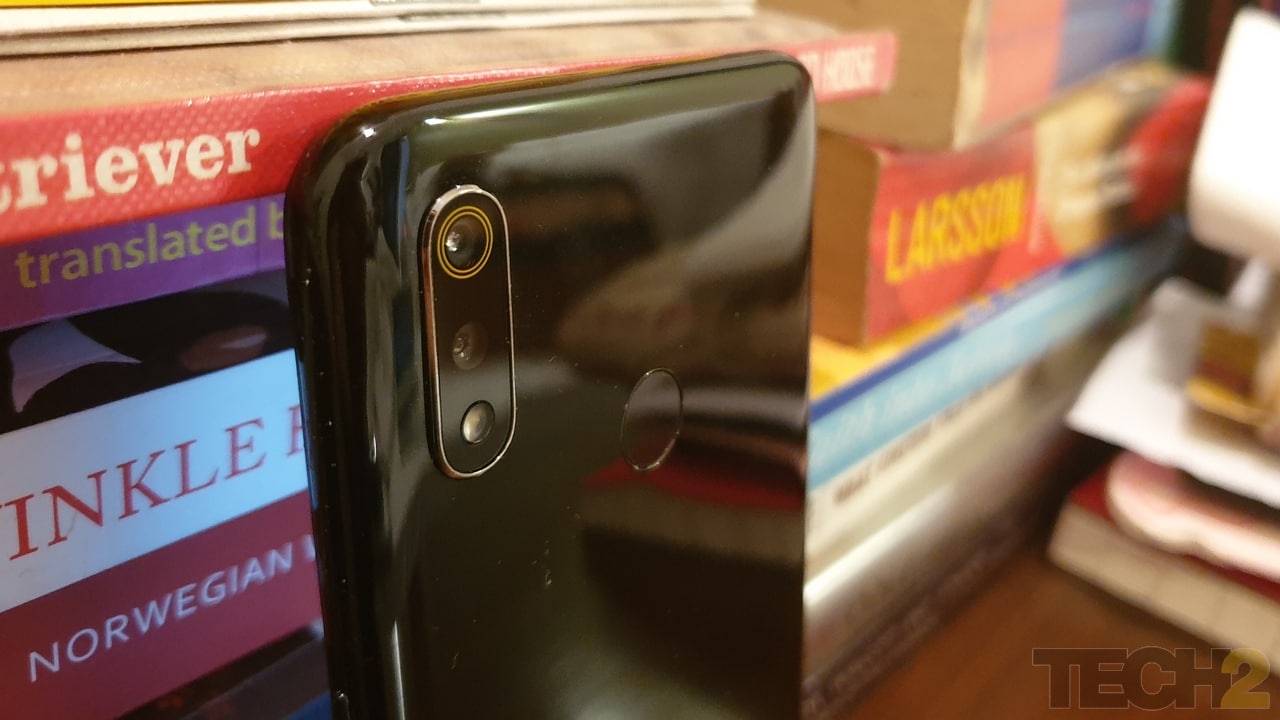 Realme 3’s primary camera features a yellow right around the lens, which follows the motif of the company’s new logo. Image: tech2/Nandini Yadav[/caption] In general, the images from this phone have an inherent yellow tint in them. Besides that, the Realme 3’s camera does not do a very good job of capturing the details when you shoot photographs in low light. If you zoom into some low light pictures in the carousel below, you will see how the details are all smudged. Focussing on a subject in low light is also a task. Also, getting a clear picture even in the day from this phone while in a moving car, or snapping a shot while walking, is almost impossible. Despite all efforts my to keep my hands steady, the dual-camera setup at the back of the device, fails to focus and this results in blurry images. You can check out the image samples in the carousel below and
click here
to go the Flickr Album.
Realme 3’s primary camera features a yellow right around the lens, which follows the motif of the company’s new logo. Image: tech2/Nandini Yadav[/caption] In general, the images from this phone have an inherent yellow tint in them. Besides that, the Realme 3’s camera does not do a very good job of capturing the details when you shoot photographs in low light. If you zoom into some low light pictures in the carousel below, you will see how the details are all smudged. Focussing on a subject in low light is also a task. Also, getting a clear picture even in the day from this phone while in a moving car, or snapping a shot while walking, is almost impossible. Despite all efforts my to keep my hands steady, the dual-camera setup at the back of the device, fails to focus and this results in blurry images. You can check out the image samples in the carousel below and
click here
to go the Flickr Album.
 During the day, the camera manages to capture some good colours, but the details in the pictures clicked, even with ample light around, are still missing. The selfie camera as well, isn’t a very impressive one, despite sporting a 13 MP sensor (with f/2.0 aperture) on the front. Low-light selfies have the same issue of burning out a little under yellow light. These images also lack focus. [caption id=“attachment_6189371” align=“alignnone” width=“1280”]
During the day, the camera manages to capture some good colours, but the details in the pictures clicked, even with ample light around, are still missing. The selfie camera as well, isn’t a very impressive one, despite sporting a 13 MP sensor (with f/2.0 aperture) on the front. Low-light selfies have the same issue of burning out a little under yellow light. These images also lack focus. [caption id=“attachment_6189371” align=“alignnone” width=“1280”]
 Realme 3 features a dewdrop notch on its 6.2-inch display. Image: tech2/Nandini Yadav[/caption]
Realme 3 features a dewdrop notch on its 6.2-inch display. Image: tech2/Nandini Yadav[/caption]
The battery will impress you
The battery of the phone, however, which is a huge 4,230 mAh one, is pretty great. On a regular day, with me placing and answering calls, using social media apps like Twitter, YouTube and Instagram, the phone’s battery easily lasted a day, and sometimes a little over it as well. And, during MWC, I was essentially, using the Realme 3 as a personal hotspot for my other device, with also some surfing through Slack, WhatsApp, and Twitter; with all of that, the phone would still easily survive some 12 hours. The battery was definitely impressive. The Realme 3 uses a microUSB port for charging, and supports the company’s own fast charging tech, that gets your phone’s juice up from zero to 100 percent in approximately an hour and a half. [caption id=“attachment_6190151” align=“alignnone” width=“928”]
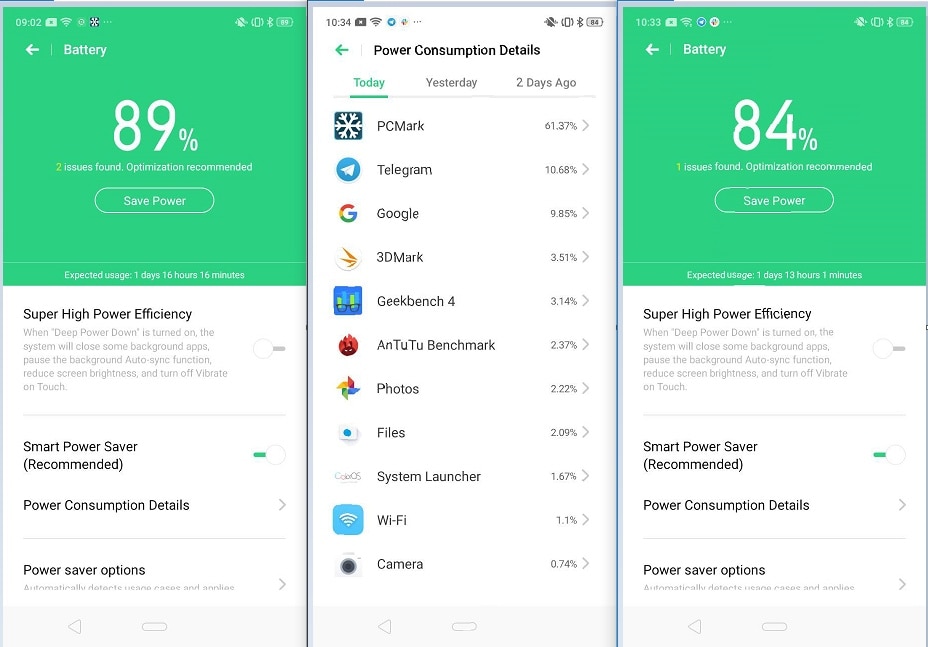 Realme 3’s battery performance.[/caption]
Realme 3’s battery performance.[/caption]
I will give it to Realme 3 for design
Design-wise, Realme has made some slight changes to the phone. The Realme 3 smartphone features a 6.2-inch display, with an 88.30 percent screen-to-body ratio. The display has a 19:9 aspect ratio and has a resolution of 1520 x 720 pixels. On top of the display sit a dew drop notch. While the bezels have been narrowed on the top and the sides of the phone, it still has a pretty prominent chin at the bottom end. [caption id=“attachment_6189911” align=“alignnone” width=“1280”]
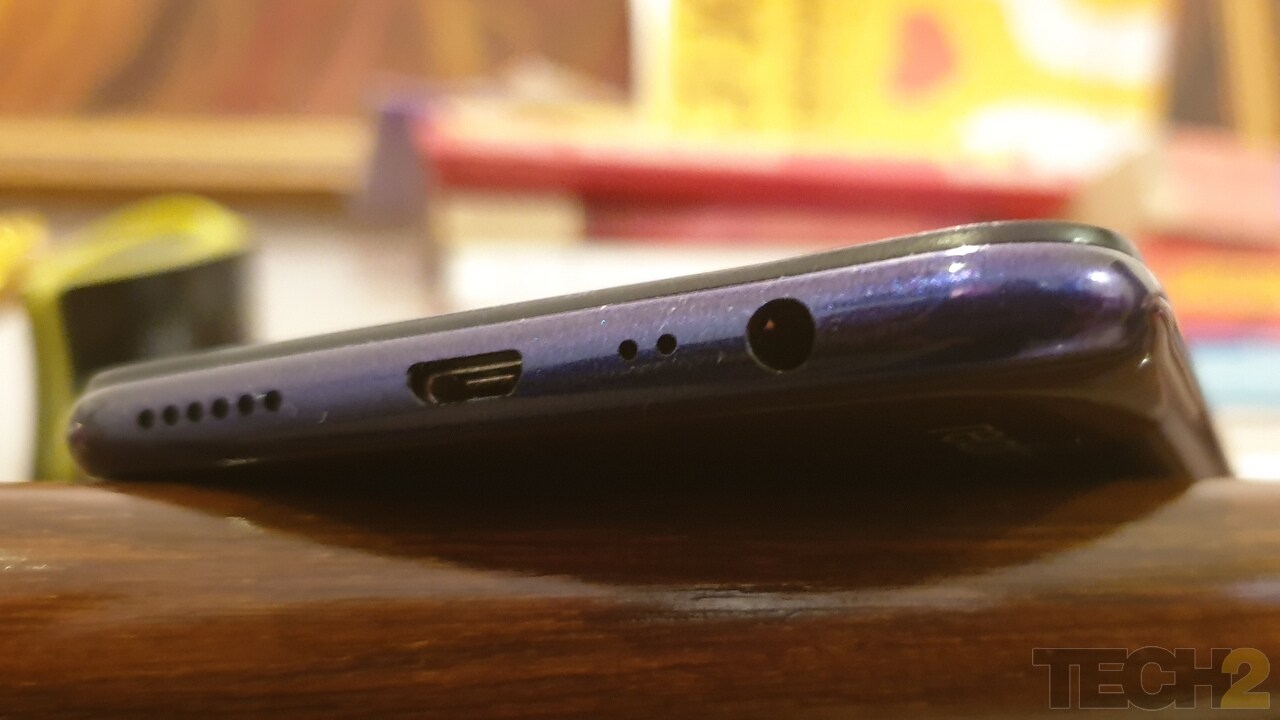 The Realme 3 does nt feature a Type-C port. Image: tech2/Nandini Yadav[/caption] The Realme 3 has a plastic back with a glossy finish. While one variant comes in a blue-green Huawei P20-like gradient, the unit I had had a black rear, with a fourth of the bottom covered in a subtle blue finish with a sparkling effect, that looks purple in different lighting environments. The phone is very comfortable to grip on to, and it fits snuggly even in tiny hands like mine. [caption id=“attachment_6189861” align=“alignnone” width=“1280”]
The Realme 3 does nt feature a Type-C port. Image: tech2/Nandini Yadav[/caption] The Realme 3 has a plastic back with a glossy finish. While one variant comes in a blue-green Huawei P20-like gradient, the unit I had had a black rear, with a fourth of the bottom covered in a subtle blue finish with a sparkling effect, that looks purple in different lighting environments. The phone is very comfortable to grip on to, and it fits snuggly even in tiny hands like mine. [caption id=“attachment_6189861” align=“alignnone” width=“1280”]
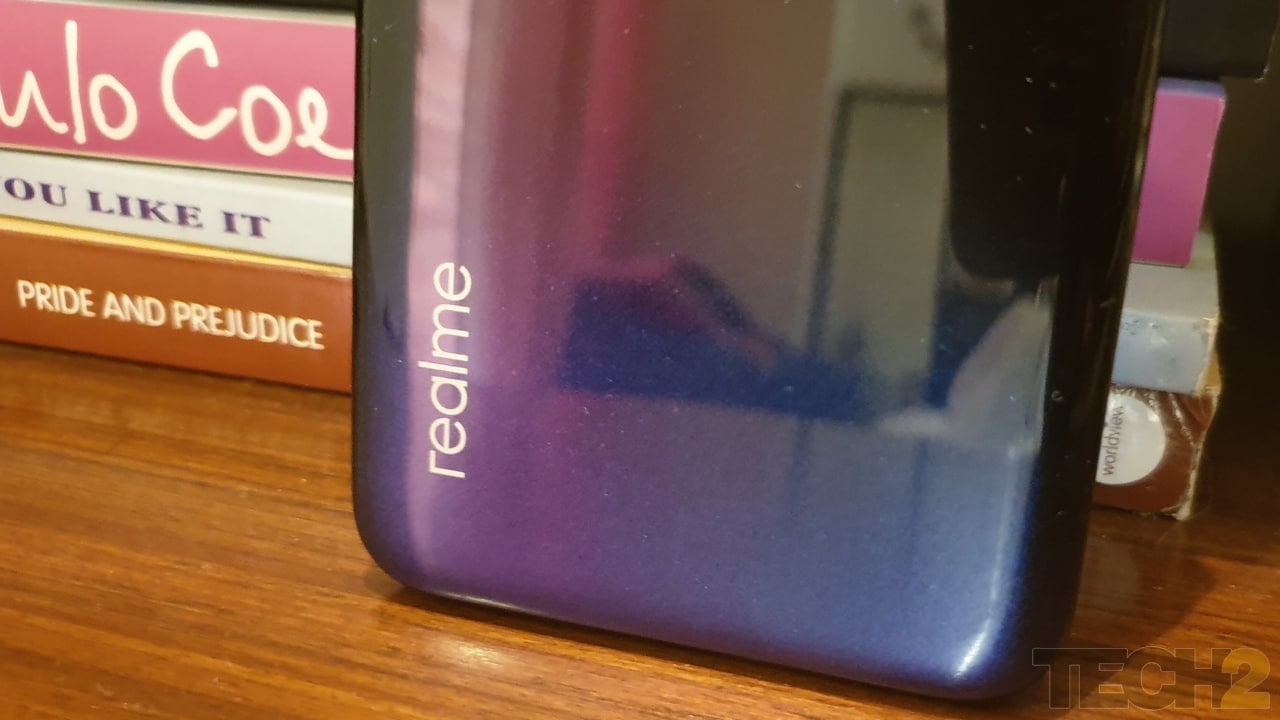 Realme 3’s widely teased Dynamic Black variants has a black back, with a blue and purple gradient at the bottom. Image: tech2/Nandini Yadav[/caption] Further, the Realme 3 features a fingerprint sensor and a 2D face recognition sensor for authentication. While the fingerprint sensor reacts quite promptly, the face recognition misses out many a time. This is especially true when you are in a dark room, or trying to authenticate when you are out at night. Having said that, when the recognition is successful, the time taken for the for phone to unlock is quick. [caption id=“attachment_6189841” align=“alignnone” width=“1280”]
Realme 3’s widely teased Dynamic Black variants has a black back, with a blue and purple gradient at the bottom. Image: tech2/Nandini Yadav[/caption] Further, the Realme 3 features a fingerprint sensor and a 2D face recognition sensor for authentication. While the fingerprint sensor reacts quite promptly, the face recognition misses out many a time. This is especially true when you are in a dark room, or trying to authenticate when you are out at night. Having said that, when the recognition is successful, the time taken for the for phone to unlock is quick. [caption id=“attachment_6189841” align=“alignnone” width=“1280”]
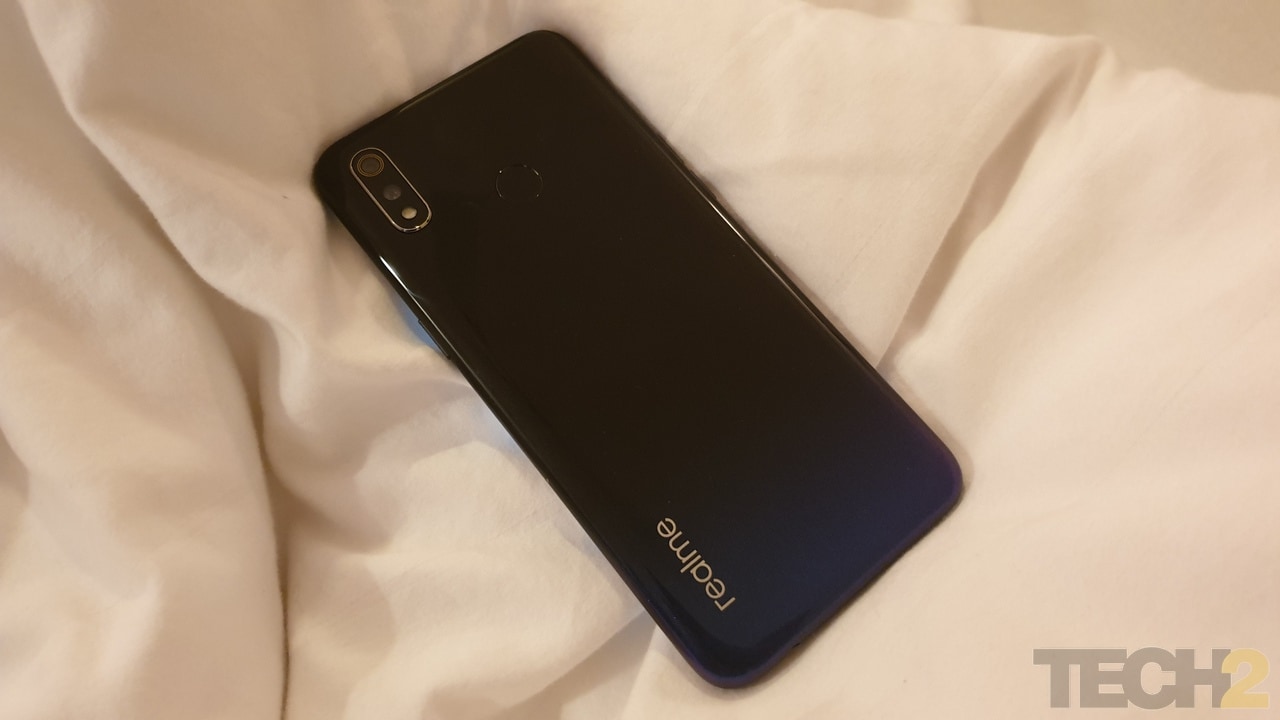 The Realme 3 has a plastic body, with a glossy finish to it. Image: tech2/Nandini Yadav[/caption]
The Realme 3 has a plastic body, with a glossy finish to it. Image: tech2/Nandini Yadav[/caption]
The UI is based on Android 9 but it’s still ColorOS
For interfacing with the device, there is Android Pie-based ColorOS 6 (the phone was also recently upgraded to the latest version of the OS). The UI is pretty standard, but aesthetically it’s not very pleasing. The device comes full of bloatware. But the only good thing here is that the UI is based on the latest Android version, so you get Realme’s version of the latest Android features. [caption id=“attachment_6191401” align=“alignnone” width=“1280”]
 Realme 3 specifications.[/caption]
Realme 3 specifications.[/caption]
Performance is decent
As for performance, the device does well. The Realme 3 is powered by a MediaTek Helio P70 chipset, which comes with options of 3 GB RAM and 4 GB RAM models. I tested the latter variants.
Launching apps was never a problem, it happened swiftly. Switching between apps did see some apps crash once or twice, but it did not happen every time. However, the camera app does seem to freeze a bunch of times. Launching the camera app, though, was a problem at times. The app would just go blank for a few seconds, and it would take a while for the camera to activate and show the viewfinder. There were also instances when the pictures I clicked would show in the tiny preview on the bottom left but would take a while to reflect in the gallery. [caption id=“attachment_6190161” align=“alignnone” width=“927”]
 Realme 3 uses Android Pie-based ColorOS 6.[/caption] Other than that, the device does not heat up. Gaming experience on the phone was also decent. I experienced no drop in frame rates, or heating issues while playing PUBG and Asphalt 9 on the phone.
Realme 3 uses Android Pie-based ColorOS 6.[/caption] Other than that, the device does not heat up. Gaming experience on the phone was also decent. I experienced no drop in frame rates, or heating issues while playing PUBG and Asphalt 9 on the phone.
So what do we have here?
A phone that looks good, performs decently, features the latest operating system, but really fails when it comes to the camera. And this is where you ask yourself again: Should I invest Rs 10,999 in the Realme 3 (or Rs 8,999 for the lower variant)? I would recommend going for the Realme 3 only if you are looking for a decent looking device in this price range, that is able to offer you a full work-day of battery life. Despite good pricing, there is so much the Realme 3 could improve on, and it should start with the camera. For anyone else, who likes to take a few selfies here and there, Realme 3 is not for you. You should rather look at the Xiaomi Redmi Note 6 Pro, which will offer slightly better performance and a considerably better. Even better, just hold on till our review of the Redmi Note 7 Pro comes out.
)